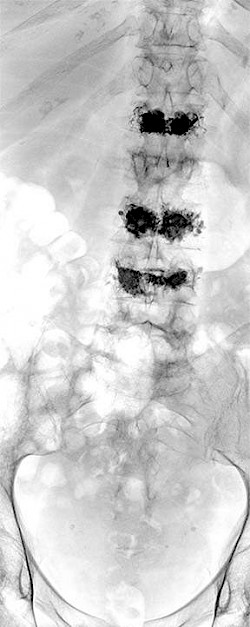Vertebral fractures in elderly persons - information, diagnosis and treatment options
What are the causes of spine fractures in elderly persons?
Even older people can suffer from a vertebral fracture as a result of a serious accident or a fall from a great height. These fractures must principally be treated the same way as they are treated in younger people.
Because of the aging process, especially women experience bone loss (osteoporosis) that may cause vertebral fractures but also minor injuries. Under certain circumstances it is already sufficient to bend over for some object or just to turn around in bed! These vertebral fractures are not unstable and the risk of damage to the spinal cord is very low. However, these fractures can cause severe pain and deformity of the spine. The real danger resulting from this, is that the pain can mean for an elderly person to be bound to the bed and being deprived from normal mobility. Prolonged bed rest may lead to complications, such as pneumonia or deep vein thrombosis. Therefore, it must be the goal of any treatment to restore a pain free mobilization of the affected person as quickly as possible.
Can a vertebral fracture suffered by an elderly person be treated the same way as a fracture suffered by a younger person?
The answer is no! Due to the in relation to young people significantly reduced bone quality of the spine, the surgeon is faced with the problem of finding sufficient bony anchorage for most of its implants. The screws and plates tear and cannot hold the break.
In these cases, the specialist must manage the surgery by a) using more screws to achieve a higher strength of the implants. However, also this method leads to a stiffening of several motion segments, which negatively affects the mobility of the spine; b) by using bone cement for solidly anchoring the implants into the bone. These implants have been available only for about three years and they represent a milestone in the management of vertebral fractures in older people.
How are vertebral fractures treated in elderly persons?
Whenever possible, a vertebral fracture suffered by older persons should be treated conservatively. The conservative treatment provides sufficient relieve of pain by means of pain medication and gentle gradual mobilization together with a stress-free movement of the back. Under certain circumstances, a stabilizing brace is very useful. An X-ray follow-up will show whether the vertebral fracture heals during treatment, or if there has been an increase of the possible resulting deformity.
 What is Kyphoplasty?
What is Kyphoplasty?
If, regardless of medication, normal mobilization of the patient cannot be restored due to the pain, an option is kyphoplasty. This is a relatively low-risk method to stabilize the vertebral body and to reduce the pain. In this procedures, two balloons are inserted and inflated in the vertebral body through two small incisions. This way, the vortex can be slightly raised and the bone in the interior of the vortex is compressed around the balloon and "compacted.” Then the balloons are deflated again and removed. The resulting cavity is filled with liquid bone cement, which solidifies within a few minutes. The vertebral fracture can be stabilized and the pain caused by the fracture is quickly relieved. This procedure allows the patient to be mobilized more easily.
Post-surgical treatment involves immediate mobilization while avoiding strenuous activities. After all, this is the sole purpose of the surgery. In general, patients reported a significant reduction of pain already the day following the operation.
What is a minimally invasive inserted screw-rod system and when do I need it?
In osteoporotic vertebral fractures, a minimally invasive screw-rod combination is inserted through small incisions. The screw-rod combination straightens the fracture from the back and supports it like a frame. This reduces surgical trauma and facilitates the mobilization of the patient. If after the straightening and stabilization of the fracture by the minimally invasive inserted screw-rod system, a cement filling of the fractured vertebral body is added, the construction can permanently have sufficient stability. The spine specialist must decide in each case whether such a system is useful or not. The goals of surgical stabilization of thoracic and lumbar spine fractures are: a) removal of bone fragments that press against the spinal cord or nerves, b) restoring the normal shape of the spine, and c) permanent stabilization of the fracture.
In a thoracic and lumbar spine surgery, these objectives are usually met by surgery from the back. Screws are inserted in the healthy vertebra above and below the fractured vertebra. If a bone fragment presses against the spinal cord from the front, the vertebral arch is removed and the spinal cord is given more space.
The screws are connected to one another by rods. The break is stabilized and maintained by this screw-rod system. Unstable vertebral fractures require after about 4 to 6 weeks a second operation from the front in which the fractured vertebra is supported by its neighboring healthy vertebrae.
After surgical stabilization of a thoracic or lumbar fracture, the patient can move around the first day after the operation, however, will still be under the supervision of a physiotherapist. The patient learns techniques that allow him to move in the first few weeks after surgery without stressing his/her back. Sitting is immediately possible. Gradually, the patient obtains normal mobility and is able to move around independently. After about 7 to 10 days, the patient can be discharged from the hospital. For the period of six weeks, the patient will continue to perform stabilizing physiotherapy to strengthen the core muscles. Sports should be discontinued for up to six months after the surgery, swimming and cycling are however allowed again after three months. A return to work is to be expected after 6 to 12 weeks - depending on the job activities.

